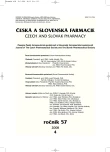Antiradical activity of substances with a potential effect on the cardiovascular system
Authors:
R. Opatřilová; Z. Kupková; J. Csöllei
Authors‘ workplace:
Veterinární a farmaceutická univerzita Brno, Farmaceutická fakulta, Ústav chemických léčiv
Published in:
Čes. slov. Farm., 2008; 57, 177-180
Category:
Excerpt
Overview
After the discovery of the antioxidant protection of biological systems, free radicals and their effects became the subject of intensive research in the process of various types of diseases. The paper focuses on the study of antiradical activity of substances from the group of heteroarylethanolamines. The site of action of these substances is the cardiovascular system, where endothelial dysfunctions may develop, oxidation of cholesterol takes place, etc. A highly reactive free radical is dinitrogen oxide (NO.), developing endogenously by the action of NO-synthase (NOS) enzyme. The principal disintegration product of an aqueous solution of nitrogen oxide are nitrites, which in the presence of hemoproteins oxidize to produce nitrates. The principal method of detection of the oxidative products of nitrogen oxide is the Griess method based on spectrophotometric determination of nitrites after diazotation of sulfanilamide and copulation with N-(1-naphthyl)-ethylene diamine with detection in the region at 540 nm. Antioxidants, substances which the organism uses to neutralize some free radicals, react on the principle of oxidation–reduction. The method of bromometry was selected to demonstrate antioxidative activity. In bromometry, the reaction of bromide and bromate gives rise to elementary bromine, which is the oxidative reagent itself. This developed bromine may, under our laboratory conditions, be considered to be “a free radical” capable of oxidizing other systems. This model makes it possible to determine how large the antioxidative capacity of the substance under study is. Both methods were compared with the method for the evaluation of antiradical activity by means of the stable radical 2,2-diphenyl-1-picrylhydrazyl (DPPH).
Key words:
antioxidant activity – Griess – DPPH – bromometry
Sources
1. Štípek, S.: Antioxidanty a volné radikály ve zdraví a v nemoci. Praha, Grada, 2000.
2. Rapisarda, P., Tomaino, A. Cascio, R.: J Agric Food Chem., 1999; 77, 4748.
3. Green, L. C., Wagner, A., Glogowski, J.: Anal. Biochem., 1982; 126, 131.
4. Crkovská, J., Štípek, S.: Klin. Biochem. Metab., 1998; 6, 82.
5. López-Cueto, G., Ostra, M., Ubide, C.: Anal. Chim. Acta, 2001, 445, 117.
6. Dovolil, J., Beneš, L.: Čes. Slov. Farm., 2001; 50, 203.
7. Kurfürst, P., Marek, J., Vančo, J., Csöllei, J.: Acta Cryst., 2004; C60, 494.
Labels
Pharmacy Clinical pharmacologyArticle was published in
Czech and Slovak Pharmacy

2008 Issue 4
Most read in this issue
- Actual acidity of the environment and efficacy of auxiliary substances used for antimicrobial stabilization of medicinal preparations prepared in pharmacies
- Monitoring of pharmacotherapy in seniors of rest homes in Brno region
- Antiradical activity of substances with a potential effect on the cardiovascular system
- A study of the properties of tablets from two types of directly compressible xylitol
